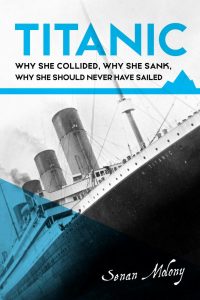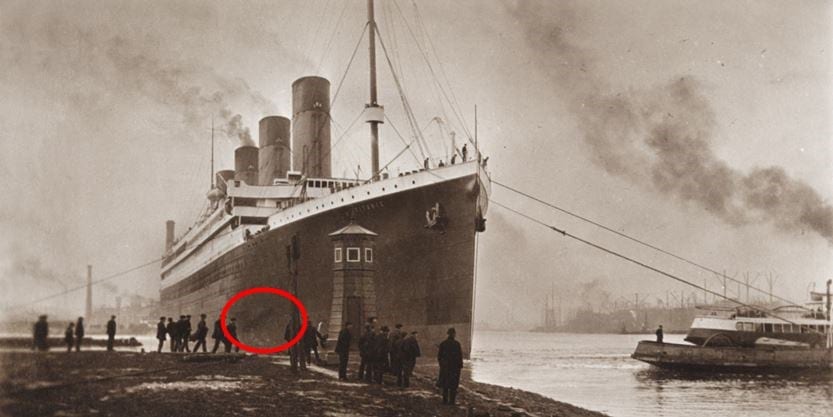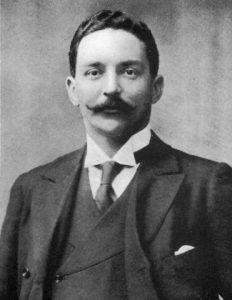 What’s that you say, it was an iceberg which sank the Titanic? Sure, but why did the iceberg cut through the ship’s steel like it was hot butter? Senan Molony, Titanic expert and author of Titanic: why she collided, why she sank, why she should never have sailed, believes he has the answer: a fire that burned for days, possibly weeks, inside the ship had weakened the hull and bulkheads.
What’s that you say, it was an iceberg which sank the Titanic? Sure, but why did the iceberg cut through the ship’s steel like it was hot butter? Senan Molony, Titanic expert and author of Titanic: why she collided, why she sank, why she should never have sailed, believes he has the answer: a fire that burned for days, possibly weeks, inside the ship had weakened the hull and bulkheads.
Amazingly enough, this fire was still burning when the Titanic sailed. Even worse, the ship’s crew knew of this but was under intense pressure to sail anyway… and they did.
A fatal shot
As History 101 explains, the new information was unearthed by Molony in 2017, when a photo album was discovered in an attic that held never-before-seen photographs of the Titanic before its maiden voyage. As he spoke to photo album owner, Titanic enthusiast Steve Raffield, Molony saw something odd in one of the photographs. At first, he thought it was a glare caused by a cast reflection or damage in the photo.
Upon further inspection, Raffield blew up the photos and realized there was a 30-foot scorch mark on the Titanic’s haul. He looked at other shots and saw the same mark in the exact same spot. The mark hovered over one of the boilers; it was a burn created from inside the ship.
Fire in the hole
Since the Titanic was a massive ship it would come to no surprise that the coal bunkers — the areas designated to store the ship’s coal — would be just as enormous. The Titanic’s coal bunkers were three stories high and housed 1.5 tons of coal.
It now looks like something heated this vast coal reserve and sparked what no fireman or furnace worker ever wants to hear: a fire in the coal bunker. The coals caught fire and the Titanic began to burn. But while the Titanic was burning from the inside, there was no outward sign of any fire.
More than a theory
Molony firmly believes that the fire significantly weakened a linchpin bulkhead, the failure of which hastened the sinking. The Titanic might otherwise have lasted until daylight, when many more passengers would have been saved by a flotilla of arriving ships.
That there was a fire seems indisputable, as the fire was mentioned in the official inquiry if 1912. John Dilley, an engine room worker, saw what was happening first hand. His account is chilling:
“There were hundreds of tons of coal stored there. We made no headway against it … we didn’t get the fire out … from the day we sailed, the Titanic was on fire”
Twelve men combated the coal bunker fire, but it wasn’t enough. The fire continued to burn when it departed from its port from Belfast to Southampton, where it would receive over 2,200 passengers ready to board and take sail across the Atlantic. With just the most basic of repairs done to the ship, the Titanic was doomed if it took on any significant amount of water. Here’s a transcript of his testimony to the official British inquiry into the sinking, courtesy of Snopes:
Question: The bulkhead forms part of the bunker – the side?
– Yes, you could see where the bulkhead had been red hot.
Question: You looked at the side after the coal had been taken out?
– Yes.
Question: What condition was it in?
– You could see where it had been red hot; all the paint and everything was off. It was dented a bit.
Question: It was damaged, at any rate?
– Yes, warped.
Question: Was much notice taken of it. Was any attempt made to do anything with it?
– I just brushed it off and got some black oil and rubbed over it.
What kind of damage could an internal fire do?
Coal fire specialist Guillermo Rein has the answer to the obvious question: what kind of damage could an internal fire do?
When heat is trapped in a bed of coal, it spreads and branches until it begins to smoke. It doesn’t take long for the coal to catch fire and it could take days, if not weeks, for someone to notice.
By the time someone senses it, it’s too late. Once a fire like that starts to burn, it’s extremely hard to put out. With that much quantity of coal, the fires can burn anywhere between 1,000–2,000 degrees Fahrenheit — the equivalent of molten lava. That melts metal — including steel.
Beside the coal bunker was one of the ship’s bulkheads — the ship’s watertight compartments. These not only ensured structural integrity but also that if the ship took on water, the water would only fill in the designated compartment.
However, the fire put continuous heat and pressure on the bulkhead’s steel. The metal became brittle and weak. Not only wouldn’t such a metal hold upon impact, it was also very prone to shattering.
The following account from “lead stoker” Frederick Barrett, described the damage to the bulkhead next to the bunker :
Question: What was the condition of the bulkhead running through the bunker?
— It was damaged from the bottom.
Question: Badly damaged?
— The bottom of the watertight compartment was dinged aft and the other part was dinged forward.
Question: What do you attribute that to?
— The fire.
Question: Do you mean to say the firing of the coal would dinge the bulkhead?
– Yes.
Even worse, this particular bulkhead was the last stronghold before reaching the boiler room. If the fourth bulkhead leading to the boiler room gave way, nothing would protect the furnaces.
When the Titanic left Southampton, the fire was still burning in the coal bunker. However, it was slightly mitigated with a few shovels and manpower. It was enough to push back the flames and make hasty repairs.
Unfortunately, the fire — still burning — warped the metal around the ship’s boiler room’s bulkhead, making it look like a buckled wave of metal. Between the welding seam of the water-tight compartment was a breach: a hole.
All the crew could do was make a patch repair and sail, crossing their fingers that they could get the Titanic to port as fast as possible.
Why, then, did the Titanic sail?
The Titanic sailed because of the sheer determination of one man: White Star Line chairman and managing director J. Bruce Ismay.
The White Star Line was struggling to compete with its competitors. Ismay and his investors were trying to keep their heads above water as they placed their bets in the transatlantic shipping wars. The competition was brutal.
Main rivals such as Cunard Line advertised how their ships were the fastest and most luxuriant ocean liner services in the world. Ismay seethed. Though Cunard Line had speed, White Star Line was going for size and opulence. Ismay’s ideas were gargantuan. However, there were also drawbacks.
A tight budget
Chief designer Thomas Andrews oversaw the construction and design of the RMS Titanic. But Ismay was on a tight budget. The company was tanking and he wanted his monolithic ships out on the water as soon as possible with little cost as possible.
As Andrews rolled out his plans for a luxurious cruise liner, Ismay insisted on budget cuts. He wasn’t talking small cuts either. Andrews argued there would be corners Ismay couldn’t cut, such as steel quality and the number of lifeboats. Ismay dismissed his concerns. When steelworkers advised Ismay that it’s best to use reinforced steel, he responded haughtily and informed the steel company that “ordinary” steel would suffice.
Not only was the company’s reputation on the line, but his reputation was on thin ice. The fire pushed the launch continuously until Ismay had enough. Wealthy investors were watching one delay after another, and the last thing the White Star Line wanted was an excuse for investors to turn their attention — and money — away.
And so, Ismay decided for the Titanic to set her maiden voyage on April 10, 1912 — fire or no fire. None of the passengers knew there was a fire burning in the ship. In fact, Ismay made sure no one knew.
Full speed ahead
The Titanic was completed during the National Coal Strike of 1912. Due to the labor conflicts, the White Star Line was under tremendous pressure — and the pressure mounted. The coal strike further affected Ismay’s budget plans. The price of coal was on the rise and one of the reasons that contributed to the sinking of the Titanic was fuel shortage.
While it stands to reason that Captain Edward John Smith would want to reach port as soon as possible in order to finally put out the fire, it makes no sense that he would push at full speed in an iceberg field. Except for two reasons: the ship needed to conserve fuel. To slow the ship down, only to speed it back up, took more coal-burning than a ship running at a continuous speed. In other words, the ship was going at top speed because it didn’t have enough fuel to slow and then speed up. If it did so, it might end up stranded at sea.
At the same time, the ship needed to sail at full speed to drawdown the coal in the bunker until the smoldering coal could be extracted and fed into the boiler. Spontaneous ignition of coal in seams, culm banks, and bunkers is well-known with a long history. At the time of the Titanic sailing, it was known as a chronic, but not an acute problem.
At full speed, the bunker fire would have had a net drawdown rate of the order of 1-in/hr. At this rate, a fire that originated in the top half of the bunker would still have been in the bunker at the time of the collision.
Into the iceberg field
With the furnaces burning hot, the ship was racing across the Atlantic at top speed (23 knots) and straight into an iceberg field. With the rate the ship was going, Captain Smith had two options: The first was to ignore the iceberg warning and hope that his crew could avoid the towering icebergs. Second, risk slowing and burning through whatever coal reserves Titanic had.
He chose the former.
On April 14, 1912, the Titanic collided with an iceberg 400 miles off the coast of Newfoundland. The iceberg struck the starboard side of the ship and scraped along the hull. It tore like tissue paper. The water quickly filled the water compartments. The water gurgled in and filled the bow of the ship.
For a while, the compartments held.
The fatal bulkhead
The fourth compartment groaned under the weight of the Atlantic as it pressed against the brittle and weak steel. It was the last barrier before the water could reach the engine room. The hastily constructed patch held as long as it could, but like a duct-taped bumper, it wasn’t meant to ward a significant amount of stress, as the following statement explains,
“when the bow was stove in, the waters readily tore open the watertight bulkheads, behind which had been this coal.”
In a wash of green and foam, the water breached the last stronghold of the ship’s walls. The ocean began to wash through the engine room. A torrent of ice-cold water flooded the engine room and filled the compartment at an alarming rate.
Had the bulkhead held, the Titanic could have stayed afloat double the amount of time. This would have been enough time for the Titanic to send out an SOS to the RMS Carpathia. Thousands could have been saved.
Instead, the ship sunk in a little over two hours. Out of the 2,200 passengers, only 706 people survived. Among them was J. Bruce Ismay.
Ismay’s response
What was the first thing Ismay did once ashore? He sent a telegram. Knowing that an inquiry — a private investigation — would follow, Ismay sent a telegram for all the hired firemen who worked the Titanic to scatter inland. He conveyed their presence was not needed for the inquiry.
At the ensuing trial, Ismay claimed at first that all the firemen on the Titanic had perished in the Atlantic.
The prosecution presented Ismay’s telegram as proof of his guilt.
But Lord Mersey, the high court judge who ruled over the inquiry, chose to ignore it. He also waved off the evidence that a coal fire was burning below the decks of the Titanic.
More evidence revealed that out of the 160 firemen hired to embark with the Titanic‘s maiden voyage, only 8 stayed on. They basically looked at the fire, turned, and said “nope.”
Still, Lord Mersey dismissed the claims, closed the case, and concluded that the reason the Titanic sank was an accident due to excessive speed and collision. The case was over, and it set the tone for the story of the Titanic for the remainder of the century. Because of this infuriating ruling, not much could be done despite the incriminating evidence.
Even though the case was ruled “accidental” and was dropped, the White Star Line never recovered. Those who did survive the sinking filed for compensation for loss of property, leading the company to bankruptcy. The White Star Line had gambled and lost horribly.
Silver Lining
While justice was hardly served, there is still a silver lining in all this: laws for cruise ships today.
Many changes have been made in regard to maritime safety years following the sinking of the Titanic. One of these regulations enforced stricter and more rigorous ice patrols in the North Atlantic. Rules regulating on-board radios were introduced (since the Titanic used Morse code to signal any nearby ships) and required that the standing crew onboard monitor the radios in case of an emergency.
In 1914, two years after the Titanic tragedy, the International Convention for the Safety of Life at Sea was formed, creating a single, global maritime standard. Finally, in 1915, it was mandated that there would be enough lifeboats onboard passenger ships.
The Titanic may have been doomed from the start. But at least it served to improve safety for countless sailors and passengers in the years to come.
For more photos, check out History 101’s original post.





A startling revelation indeed, Nicholas. I have read a few books about the Titanic over the years, and watched every film and documentary about the sinking. But this is the first time I have ever heard about the fire. This should be National News!
Best wishes, Pete.
LikeLiked by 1 person
Apparently it made a splash back in 2016 when the news first appeared. But I only just heard about it myself!
LikeLiked by 1 person
Same here!
LikeLiked by 1 person
Reblogged this on Chris The Story Reading Ape's Blog and commented:
Sometimes, it’s what they DON’T say in history, that matters most..
LikeLiked by 2 people
Interesting. I’ve been fascinated by stories of the Titanic for as long as I remember. I’ve never heard about this until now.
LikeLiked by 1 person
Me neither. Hard to fathom, really–you’d think it’s worth mentioning when your ship’s on fire!
LikeLiked by 1 person
You would think!
LikeLiked by 1 person
Wow, this is shocking news, Nicholas. Once more human greed had jeopardized people and their lives. How appalling.
LikeLiked by 1 person
I’d like to say that things are different now but yeah…
LikeLiked by 1 person
Wow! What people will do just to make money! It just adds to the tragedy of the story! Thanks for sharing!
LikeLiked by 1 person
Sadly enough, you’re right! Thanks and welcome 🙂
LikeLike
An interesting post, Nicholas. Thanks for sharing. 🙂 — Suzanne
LikeLiked by 1 person
Thank you, Suzanne! I’m glad you enjoyed the post 🙂
LikeLike
Reblogged this on Marina Costa and commented:
Very interesting!
LikeLiked by 1 person
I had no idea. How tragic.
LikeLiked by 1 person
Quite so! You’d think it’s worth mentioning in the trial verdict but nah…
LikeLiked by 1 person
This theory is more believable, even a collision with an iceberg sounds more romantic. 😉 Happy Monday evening, Nicholas! Have a wonderful week. By the way, 20 years in the past, for a trip to Egina i used one of the Flyboots, and felt like on the Titanic. Lol Michael
LikeLiked by 1 person
Lol–no icebergs in the Saronic Sea just yet, thankfully 😀
LikeLiked by 1 person
😀😀
LikeLiked by 1 person
There is a very good documentary made about this and shown on one of the history channels quite recently: last year, I think? I certainly wasn’t aware of the fire down below, hitherto. This is a tragic story of greed and the arrogance of the British legal system.
LikeLiked by 1 person
Thankfully, nothing like this could happen today (roll of eyes)
LikeLiked by 1 person
You think? 😉
LikeLiked by 1 person
Amazing story. I had never heard anything about this before. Thanks so much for bringing it to my attention. I will be looking for this book.
LikeLiked by 1 person
Thanks! Glad you liked the post 🙂
LikeLike
Fascinating.
LikeLiked by 1 person
I thought so, too!
LikeLiked by 1 person
Cruises seem to be one of the safest ways to travel and I can thank the Titanic disaster
LikeLiked by 1 person
Agreed. At least some good came out of it!
LikeLike